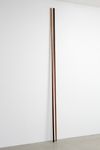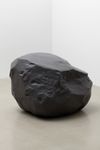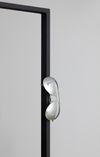Christian Andersen, Frederiksholms Kanal 28A, 1220 Copenhagen K, +45 2537 4101, info@christianandersen.net
Images
Press release
So “mouthbreather” is a derogatory term for someone who for whatever reason doesn’t breathe through the nose but mouth, obviously. These people just seem to bumble through life with open faces and in the drizzling rain they might even squint and letting their tongues hang out careless of the world around them. Just taking it all in. Like some whale shark trawling the ocean for plankton. Or perhaps the more aesthetic Manta Ray gliding luminescent over a darkened coral reef in the night. Seen from the front it looks completely hollow just a thin membrane for a body. Underneath it the busy calcium carbonate structure disappears and it drifts into a horizonless black. The unforgiving sea, cold and vindictive.
My father was hit by a car when he was ten or eleven and lost in the accident some eighty percent of his hearing plus his general sense of direction and balance. He was a fan of the sea hero Jacques Cousteau and dreamed himself away on aquatic adventures with the crew of the brave ship Calypso. He would float around in the local swimming pool just staring down at the tiled bottom floors imagining himself steering Cousteau’s iron lung alongside the bottom of some yet undiscovered ocean-topography. Maybe a blinking jellyfish would flash by or the angry mouth of a deep-sea fish would be illuminated by a glowing tentacle dangling from its forehead. Was it this monstrous mermaid that one day lured him out into the deep end of the pool only to let him dive down to the bottom? Sliding along the sloping surface of the porcelain floor he had closed his eyes transporting himself to a long-sunken oil tanker. Around him dances a school of herring in precise coordination, he feels the pressure changing in the water when they turn in sudden jerks. They pass overhead and the world goes black.
As he opened his eyes he realized to his horror that the basin was transformed into a symmetrical space. He was trapped in a flooded tile box. The water’s roof mirrored the pool floor and with a failing vestibular system all spatial navigation was suspended. Swimming in panic to what he guessed to be the surface he was only met by the cold plate-like surface of tiles banging back at his knuckles and knees. Bubbles. Then the numbness and inertia. For a second he just hung there with limbs spread to either side like one of those deep-sea bugs feeding on tiny flakes of excrement drifting down from the upper floors of the ocean. Cousteau where are you? The moment before his diaphragm was about to contract in a final breath, he saw in the corner of his eye a tiny silvery sphere detaching from the side of his nostril spiralling upwards to safety. Bubbles. He saw how it silently broke the mirror in expanding, concave rings and followed desperately after. And this is how the most unlikely of things suddenly becomes a guideline, an agents of a wider perspective.
A rock that sits heavy in the field, which the farmer has to tow away with big machines has once embarked on a similar route. Five hundred thousand years or more ago it broke loose from some magma chamber deep in the earth’s fiery heart and went on a trip partly dictated by its inherent “stone-ness” and partly its context, the blind earth. The stone is propelled upward by two factors: Its ability to conduct cold forms an ice mantle on the underbelly of the stone during frost. In the spring this mantle thaws whereby soil is pressed into the newly formed cavity underneath it. In this way it is elevated further up. Up to the waiting field in which it will eventually lie heavy and burdened almost as if longing back to its liquid family in the Earth’s smouldering core.
I remember walking home from a parents meeting with my dad. The teachers had told me that I should pay more attention to the board than gazing out the window. We walked in silence. On the way I picked up a big flint stone and maybe in my frustration I threw it on the pavement, shattering it. “What are you doing?” He asked me accusingly. “This stone might have spent thousands of years to come this far and what do you do break it that’s what!” He couldn’t know that this would keep me awake for years to come. My eyes teared up in shame. “Hey, I’m only kidding!” He said and laughed.
Rolf Nowotny, 2010







